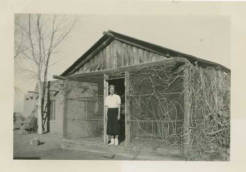
The House at Otowi Bridge: The Story of Edith Warner and Los Alamos by Peggy Pond Church (UNM)
New Mexico and its residents played a vital role in World War II, from its National Guard Troops in Bataan, to Navajo Code Talkers, military bases, internment and prisoner of war camps, and the once ultra-secret Manhattan Project. As happened elsewhere, the war had a lasting impact on the rural, agricultural New Mexico landscape. A rise in population, the establishment of nuclear related scientific facilities, and an increase in military personnel, saw a post-war New Mexico created by the relationship between science, technology, the military, and the federal government.
Edith Warner, a native of Pennsylvania, first visited a guest ranch in Frijoles Canyon for several months in 1922. She returned for good in 1928, and lived for more than twenty years as a neighbor to the Indians of San Ildefonso Pueblo, near Los Alamos. A part time job at the Los Alamos Ranch School allowed her to support herself, and in addition she operated a small store and tea room, until the coming of the Second World War forced her to close shop. Instead, she served dinners for the scientists working at the secret Manhattan Project, and became a friend to all.
Author and poet Peggy Pond Church was born near Watrous, New Mexico and later lived at the Los Alamos Ranch School, which was founded by her father, Ashley Pond Jr. In the 1920s she married a teacher at the school, and they lived there for twenty years, until the federal government took the buildings for the Manhattan Project. Her work of poetry, Ultimatum for Man (1946) reveals the pain she felt at being forced to leave their home, school and livelihood. She and her husband moved to Taos, and to California, before settling in Santa Fe, where she lived from 1960 until her death in 1986. In addition to the House at Otowi Bridge she wrote several volumes of poetry which are still in print. Church was named a Santa Fe Living Treasure, and received the Governor’s Award for Excellence in the Arts.
The House at Otowi Bridge: the Story of Edith Warner and Los Alamos has been called a “dual memoir” of two remarkable women, their friendship, and their chance connection to one of the twentieth century’s most secret and world-changing projects which happened to take place at Parjarito Plateau. First published by UNM in 1960, this look at a cultural crossroad of Northern New Mexico during the war, and its changing emergence into the modern post-nuclear Los Alamos, is still in print.
Other works about this time period: The Woman at Otowi Crossing by Frank Waters (Swallow Press, 1987), a fictionalized telling of Edith Warner’s story; Edith’s own words, In the Shadow of Los Alamos: Selected Writings of Edith Warner (UNM, 2008); Jon Hunner’s Inventing Los Alamos: the Growth of an Atomic Community (U of Oklahoma Press, 2004); and At Home in the Slopes of Mountains: the Story of Peggy Pond Church by Sharon Synder (Los Alamos Hist. Soc., 2011)
